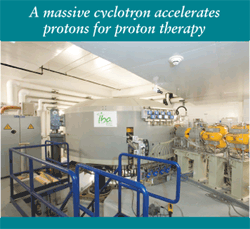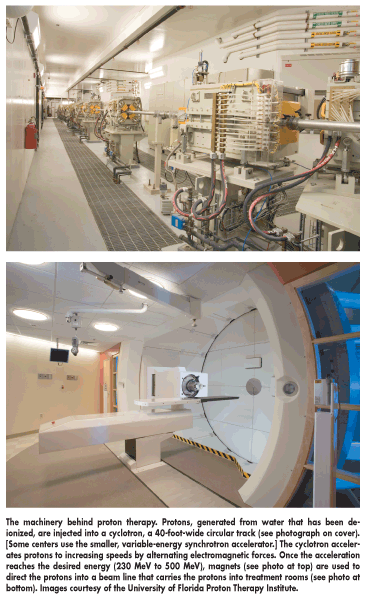How many proton beam therapy centers are enough? The United States now has 5 in operation with at least 10 more on the horizon (see Table 1). The price tag is mind-boggling, upward of $200 million for a single PBT facility. To justify this huge capital investment, a proton center needs a strategic model, in other words, a high-volume disease, such as prostate cancer.
Promoted as reducing the risk of the side effects men fear most-such as impotence-more and more prostate cancer patients are choosing proton therapy, raising concern that proton centers are being built using prostate cancer as a de facto business model.
“Proton therapy has theoretical advantages in prostate cancer, but it should be thoroughly investigated by those with no commercial bias,” Anthony Zietman, MD, Department of Radiation Oncology, Massachusetts General Hospital, told Oncology News International in an interview. The Francis H. Burr Proton Therapy Center is located at Mass General.
Table 1. Proton facilities operating in the US
- The James M. Slater, MD, Proton Treatment and Research Center - Loma Linda, California
- Midwest Proton Radiotherapy Institute at Indiana University - Bloomington, Indiana
- Francis H. Burr Proton Therapy Center - Massachusetts General Hospital-Harvard, Boston
- M.D. Anderson Proton Therapy Center - Houston
- University of Florida Proton Therapy Institute - Jacksonville, Florida
Selected proton facilities under development in the US
- The Roberts Proton Therapy Center at University of Pennsylvania Health System, Philadelphia
- Hampton University, Hampton, Virginia
- Seattle Cancer Care Alliance
- The Oklahoma ProCure Treatment Center, Oklahoma City
- Siteman Cancer Center – St. Louis, Missouri.
- The Northern Illinois Proton Treatment and Research Center -- Chicago
Proponents of PBT contend that its unique dose-distribution makes it the best option in several anatomically difficult cancers, such as skull-based tumors, ocular tumors, and pediatric malignancies. For example, researchers at Harvard reported excellent long-term results with minimal side effects in treating skull-based tumors with proton therapy (Hoch et al: Am J Surg Pathol 30:811-818, 2006). However, the cancers in which proton therapy have proven efficacy over other therapies are relatively rare.
Dr. Zietman stressed that while there is increasing enthusiasm for proton therapy, there have been no randomized trials comparing the efficacy of protons and IMRT in localized prostate cancer.
“PBT has tremendous promise in prostate cancer, but there’s a high price tag, so we need to be certain that it’s better than any alternative treatment,” Dr. Zietman said.
Since 1990, when Loma Linda University Medical Center (LLUMC) opened the world’s first hospital-based proton center, about 8,000 US men with prostate cancer have undergone proton therapy. There are 5 proton centers operating in the United States, 3 under construction, and about 10 in the planning stage (Table 1).
According to Jon Slater, president and CEO of Optivus, the US market is ripe for growth. Optivus is the company that engineered hospital-based proton therapy at Loma Linda. The Loma Linda proton center was recently named for proton therapy pioneer James M. Slater, MD, who is Jon Slater’s father.
“Looking at the history of radiation oncology, in which new modalities offer more precise treatment, I see proton beam therapy as a replacement for x-ray radiation therapy,” Mr. Slater told ONI.
Asked whether the costs of PBT to our healthcare system are justified, Mr. Slater said, “This year, proton therapy will generate about $100 million in clinical revenue out of a system that spends $2 trillion on healthcare. I think if there is interest in cutting costs, one of the last places you should look is proton therapy.”
The allure of PBT
Each year in the United States, more than 180,000 men are diagnosed with prostate cancer, providing a massive potential market for PBT centers. Cancer survivors make powerful arguments for the treatment that saved their lives.
Bob Marckini, a survivor of prostate cancer known as “Proton Bob,” became a dedicated advocate of proton therapy following his treatment at Loma Linda. Seeing his older brother suffer complications of a radical prostatectomy set Mr. Marckini in search of a different clinical path when, shortly after his brother’s ordeal, he also was diagnosed with prostate cancer.
“Seeing my brother after surgery scared me to death. He had lost 6 pints of blood, and he was connected to tubes, drains, and catheters. When I was diagnosed, I immediately began to search for another option,” Mr. Marckini told ONI.
Each doctor consult, however, only added to Mr. Marckini’s confusion. “It seems I was the ideal candidate for surgery, cryotherapy, seeds, and external beam radiation,” he said.
A chemical engineer by profession, Mr. Marckini’s research background helped him wend through a labyrinth of medical opinions. After speaking with dozens of former proton therapy patients, he chose Loma Linda for his treatment, largely based on the belief that PBT offered a better side-effects profile for “the two things men with prostate cancer fear most-impotence and incontinence.”
Mr. Marckini’s positive experience with PBT inspired his 2006 book, You Can Beat Prostate Cancer, and led him to establish a proton therapy advocacy/support group, boasting a worldwide membership of 3,300 men.
Are randomized trials needed?
As use of PBT grows, so does the debate over the need for randomized clinical trials comparing proton therapy with conventional x-ray therapy. Clinicians who oppose randomized trials make the case that scientific knowledge dictates that protons can provide superior therapy, compared with x-rays, in almost all clinical situations.
Loma Linda’s medical director, Jerry Slater, MD (whose brother is Jon Slater), said in an interview that proton beams offer significant advantages in sparing normal tissue. Unlike x-rays, the peak proton dose occurs precisely within the tumor volume.
“It has been shown numerous times that the amount of normal tissue you can miss with proton therapy, compared with other treatments, is a factor of three to four times,” said Dr. Slater, who is also director of clinical affairs for the Department of Radiation Medicine at LLUMC. He believes that a trial looking at equivalent doses of x-rays vs protons would be unethical.
“We didn’t do those trials for IMRT, 3D conformal RT, or cobalt therapy because the end result would be giving patients unnecessary doses of radiation to healthy tissue,” he said.
The University of Florida Proton Therapy Institute, which opened in August 2006, treats an average of 90 patients a day and more than 600 annually. Approximately 70% of patients at the Institute are being treated for prostate cancer, executive director Stuart Klein, MHA, told ONI.
Mr. Klein said that he does not think randomized trials comparing proton therapy with conventional x-ray therapy are needed. “We do, however, support clinical trials in proton therapy for prostate cancer as well as other disease sites,” Mr. Klein said.
In oncology, best practice often trumps economics, and new treatments such as PBT may be introduced into clinical practice without economic analysis. To some clinicians the debate over randomized trials is a smokescreen for the real issue-money.
“To balance out the cost issue between proton therapy and IMRT, you have to separate cost and effectiveness. We do not know the cost of proton therapy because we haven’t yet maximized its effectiveness,” Dr. Jerry Slater said.
To him, the debate over cost is myopic. “What I’m doing today in prostate cancer is not what I’ll be doing 5 or 10 years down the road. I’m looking to reduce the number of treatments per patient. Personally, I think that proton therapy will eventually become our single most cost-effective therapy for prostate cancer,” he said.
But some radiologists argue that solid data are needed to resolve the clinical and economic conundrum surrounding PBT. During an interview, ONI deputy editor Joel Tepper, MD, professor of radiation oncology, University of North Carolina School of Medicine, said that strong clinical data demonstrating the effectiveness of PBT in common cancer sites are needed; in some, but not all situations, a randomized clinical trial is necessary.
Dr. Tepper took exception to the commonly held premise that because of its dose-distribution advantage, protons are necessarily a better treatment option in all clinical settings.
“The basis for that supposition is fairly weak. In fact, there are some situations in which x-rays appear to have a clear advantage over protons,” Dr. Tepper said. He cited lymph nodes in the neck, due to the skin-sparing effects of photons, as an example in which x-rays might produce better results. “Protons have major problems with bone and air cavities, which can make the dose-distribution far from optimal,” he said.
Although protons are touted as a better treatment for prostate cancer, he said, “to date, there are virtually no data, not even phase II, showing that proton therapy has an advantage over IMRT in terms of decreased morbidity or improved local tumor control.”
Considering the dearth of even suggestive data, Dr. Tepper said that it is hard to justify wide acceptance of such a costly treatment when several less costly options are available.
“There is no question that a lot of the current development of proton beam centers is related to finances. In fact, the reimbursement for protons is extremely high compared to coverage for standard x-rays,” Dr. Tepper said.
Speaking from the Midwest Proton Radiotherapy Institute in Bloomington, Indiana, Allen F. Thornton, MD, said he had treated 32 patients that day with proton therapy, about 30% for prostate cancer.
Asked about concern over a lack of data supporting PBT in prostate cancer, he responded, “There’s no doubt that protons are the most elegant form of radiotherapy. However, in prostate cancer, it has not yet been determined if the incremental advantage of protons justifies the cost. It’s just too early to tell.”
However, although the efficacy data are not yet available, “the rectal complication rates in prostate cancer are definitely lower with protons,” he said.
Dr. Thornton expressed dismay at some of the perverse incentives driving the marketing of proton therapy in the burgeoning prostate cancer population, in which patient selection is a crucial component of good outcomes.
Men with aggressive, high-grade tumors have repeatedly done very well with the intensified dose-delivery of proton therapy, in part, because of the lower rectal complication rates.
“Studies have shown that dose escalation gives the best results in high-grade tumors, and PBT is the way to deliver it,” Dr. Thornton said. “But men with early stage, low-grade tumors have a lot of other options, and I give my patients the pros and cons of all of them.”
UK plans national trial
According to ONI advisory board member, Piers N. Plowman, MD, of St. Bartholomew’s Hospital, London, Europe’s approach to PBT is slightly more circumspect than that of the United States. Dr. Plowman said that the best established PBT unit is in Paris, where they have used protons with success in skull-based lesions.
“The current controversy is whether proton therapy is actually better than other forms of focal therapy such as the Gamma Knife [Leksell] and CyberKnife [Accuray]. The same discussion applies to the rest of the body,” Dr. Plowman said.
He said that at least one new proton therapy facility will be built in the UK within the next few years, and plans are underway to conduct a national trial examining the clinical suitability of PBT vs other forms of focal radiotherapy.
“Since protons have no intrinsic radiobiologic advantage over photons, cost constraints will probably argue in favor of photon focal stereotactic methods, such as CyberKnife,” Dr. Plowman said.
Table 2. Interesting facts about proton beam therapy treatment centers
- The transit time for protons from the ion source to the patient or the test stand is about 0.0001 seconds. The distance traveled about 6 miles.
- The beam is about the size lead in a No. 2 pencil.
- The four magnets on the stage cyclotron weigh about million pounds, roughly the same jumbo jets (747s).
- The annual power bill is approximately $650,000.
- The particle accelerator weigh 440,000 pounds.
Value vs cost: Who decides?
ONI board member Jay S. Cooper, MD, director, Maimonides Cancer Center, Brooklyn, views the evolution of proton beam therapy much like that of the new targeted biologics coming out of the laboratory.
“Just like medical oncologists, we are getting better and better at targeting the tumor and damaging less of the intervening tissue. That’s the Holy Grail of radiation, and, in theory, that’s what proton therapy seeks to do,” Dr. Cooper said.
He pointed out that the current tug of war in proton therapy illustrates an important ethical conundrum: “Proton generators probably would not have caused any concern or controversy if they weren’t so incredibly expensive. We are forever making incremental advances, and they come at a fairly marked expense to society. We have to decide if they’re worth it.”





